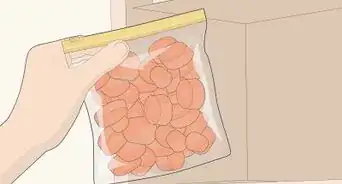wikiHow is a “wiki,” similar to Wikipedia, which means that many of our articles are co-written by multiple authors. To create this article, 13 people, some anonymous, worked to edit and improve it over time.
There are 9 references cited in this article, which can be found at the bottom of the page.
The wikiHow Culinary Team also followed the article's instructions and verified that they work.
This article has been viewed 313,928 times.
Learn more...
If you have more zucchini than you can use within a short amount of time, consider freezing it. Zucchini should be cut or shredded into manageable pieces and blanched before storing it in the freezer. Here's how to do it.
Steps
Preparing the Zucchini
-
1Use ripe, fresh zucchini. Use firm, ripe zucchini with a uniformly dark color. The color of the zucchini is a good indication that it has not become overripe.[1]
- Do not use zucchini that is pale or soft. Also avoid zucchini that has bruises, deep scratches, or rotted spots.
- If possible, use zucchini that has been freshly harvested from the garden. If buying zucchini from the store, make sure that it is in the refrigerated section and in ripe condition.
- If you cannot freeze the zucchini right away, refrigerate it until you can. Make sure that it is still in firm, ripe condition before freezing it, though.
-
2Wash the zucchini. Rinse the zucchini under cold to lukewarm water, scrubbing it gently with your hands to remove any dirt or residue stuck to the skin.[2]
- If necessary, you could also gently scrub the skin with a soft vegetable brush.
Advertisement -
3Slice or shred the zucchini. Determine which form you plan to use the zucchini in. Process the zucchini in that form to prepare it form blanching and freezing.[3]
- Use a sharp knife to remove 1/4 inch (6.35 mm) from each end of the zucchini.
- If slicing the zucchini, use a knife to cut the remainder of the vegetable into 1/2-inch (1.27-cm) thick slices.
- If cutting the zucchini into small cubes, begin by first cutting the zucchini in half lengthwise. Remove the seeds with a metal spoon and cut the vegetable into cubes.
- If shredding the zucchini, use a box grater to grate the remainder of the zucchini into fine shreds.
- You could also use a food processor to coarsely chop the zucchini into shreds.[4]
Blanching the Zucchini
-
1Fill a large stockpot with water. When blanching slices or cubes of zucchini, you should fill the pot 2/3 full with water and set it to boiling over high heat.
- Prepare a steaming basket for grated zucchini. Grated zucchini needs to be blanched, too, but it should be blanched using steam instead of boiling water. Fill the pot with roughly 2 inches (5 cm) of water and place a steaming basket or other mesh basket over the pot. Bring the water to a boil over medium-high to high heat.
- Blanching is a beneficial step because it removes the enzymes and bacteria that cause the zucchini to lose flavor, color, and nutrition over time. If you do not blanch the zucchini, it will discolor relatively quickly, even when stored in the freezer.
- Do not add any salt to the water. When blanching vegetables to eat immediately, salt makes them more flavorful. When blanching vegetables to store them, however, adding salt can actually cause the vegetable to lose moisture and break down faster.
-
2Fill a large bowl with ice water. Add a dozen or so ice cubes to a large bowl of cold water.
- The cold water should be prepared before you blanch the zucchini.
-
3Blanch the sliced or shredded zucchini. Sliced or cubed zucchini is blanched by adding it directly to the boiling water.[5] Shredded zucchini is blanched by steaming it in a basket placed over the boiling water.
- Cook sliced zucchini, uncovered, in the boiling water for 3 to 4 minutes. It should still be firm when you take it out.
- Place shredded zucchini in your steaming basket and cover the pot. Steam the zucchini for roughly 2 minutes, or until it becomes translucent.
- You can safely reuse blanching water for up to five batches. Make sure to refill the pot with additional hot water as the water level drops, though.
-
4Immediately transfer the blanched zucchini to the ice water. As soon as the blanching process is over, use a slotted spoon to transfer the zucchini from the boiling water or steam and into the bowl of ice water.[6]
- Suddenly dunking the zucchini in ice water immediately stops the cooking process.
- Keep the zucchini in the ice water for approximately the same amount of time you kept it in boiling water or steam.
-
5Drain the zucchini. Scoop the zucchini out of the ice water using a slotted spoon and transfer it to clean paper towels. Pat dry.[7]
- You could also transfer the zucchini to a colander and allow it to drain on its own. Either way, make sure that the zucchini is dry before attempting to freeze it.
Freezing the Zucchini
-
1Spread pieces of zucchini out on a shallow baking sheet. Arrange the zucchini so that the slices are in a single layer.[8]
- Pre-freezing the zucchini prevents the zucchini from sticking together in the freezer, making it possible to measure out precise amounts of frozen zucchini rather than thawing the entire batch.
- Make sure that the pieces do not overlap or touch each other. Any pieces that overlap are likely to stick together.
- Note that this pre-freezing stage is not necessary if you are using shredded zucchini.
-
2Freeze the zucchini. Place the tray in the freezer and let it sit there for 1 or 2 hours, until the zucchini has frozen solid.
- Larger pieces will take longer to freeze than smaller ones.
-
3Place the zucchini in long-term storage containers. Scoop the zucchini off the baking sheet using a flat spatula and transfer the pieces into freezer-safe plastic bags or plastic containers.[9]
- Leave roughly 1/2-inch (1.27-cm) of empty headspace at the top if each container to allow the zucchini room to expand as it freezes.
- Avoid using glass containers, which are more likely to shatter in the freezer.
- If using a bag, make sure that you squeeze as much air out of the bag as possible. The closer it is to being airtight, the longer it will last without getting freezer burn or losing flavor.
- Label the bag or container with the current date so that you can keep track of how long you've had the zucchini in storage.
- Divide shredded zucchini into pre-measured amounts based on how much you anticipate needing at a time. For instance, you could try separating the zucchini into 1 cup (250 ml) portions. Place each portion in its own separate bag or container and label with the current date as well as the amount.
-
4Freeze the zucchini until ready to use. Blanched zucchini can be frozen for 9 to 14 months depending on how airtight the seal is and how cold the freezer is kept.[10]
- After thawing out the zucchini, use it within 3 days and do not attempt to re-freeze it.
Community Q&A
Did you know you can get answers researched by wikiHow Staff?
Unlock staff-researched answers by supporting wikiHow
-
QuestionCan you freeze fresh zucchini without blanching?
 wikiHow Staff EditorThis answer was written by one of our trained team of researchers who validated it for accuracy and comprehensiveness.
wikiHow Staff EditorThis answer was written by one of our trained team of researchers who validated it for accuracy and comprehensiveness.
Staff Answer wikiHow Staff EditorStaff Answer
wikiHow Staff EditorStaff Answer -
QuestionCan you cook zucchini and then freeze it?
 wikiHow Staff EditorThis answer was written by one of our trained team of researchers who validated it for accuracy and comprehensiveness.
wikiHow Staff EditorThis answer was written by one of our trained team of researchers who validated it for accuracy and comprehensiveness.
Staff Answer wikiHow Staff EditorStaff Answer
wikiHow Staff EditorStaff Answer -
QuestionWhat can I do with frozen zucchini?
 Community AnswerPlace the frozen zucchini a pot with 1/4 cup of water. Add onions and sliced tomatoes and simmer until the onions are tender. Sprinkle some cheddar cheese over the top and serve.
Community AnswerPlace the frozen zucchini a pot with 1/4 cup of water. Add onions and sliced tomatoes and simmer until the onions are tender. Sprinkle some cheddar cheese over the top and serve.
Things You'll Need
- Kitchen knife
- Metal spoon
- Box grater
- Food processor
- Stockpot with lid
- Steaming basket
- Large bowl
- Slotted spoon
- Paper towels
- Colander
- Baking sheet
- Flat spatula
- Freezer-safe plastic bags or plastic containers
References
- ↑ https://www.thekitchn.com/the-best-way-to-pick-a-great-zucchini-ingredient-intelligence-206023
- ↑ https://extension.umaine.edu/publications/4336e/
- ↑ https://www.myrecipes.com/how-to/video/slicing-zucchini
- ↑ http://www.simplycanning.com/freezing-zucchini.html
- ↑ https://www.epicurious.com/expert-advice/how-to-store-zucchini-and-summer-squash-and-freeze-for-long-term-storage-article
- ↑ https://www.epicurious.com/expert-advice/how-to-store-zucchini-and-summer-squash-and-freeze-for-long-term-storage-article
- ↑ https://www.food.com/how-to/freeze-zucchini-57
- ↑ https://growagoodlife.com/freeze-zucchini/
- ↑ https://www.thekitchn.com/how-to-freeze-zucchini-57275
About This Article
To freeze zucchini, rinse it off and cut into 1/2 inch slices or cubes. Bring a pot of water to a boil, add the zucchini pieces, and boil them for 3-4 minutes. Next, plunge the zucchini into an ice bath for 3-4 minutes, drain the zucchini, and pat it dry. Then, arrange the pieces in a single layer on a baking sheet and freeze them for 1-2 hours before transferring the pieces to freezer-safe bags or containers. Store your zucchini in the freezer for up to 14 months! For tips on preparing shredded zucchini for freezing, read on!




















































